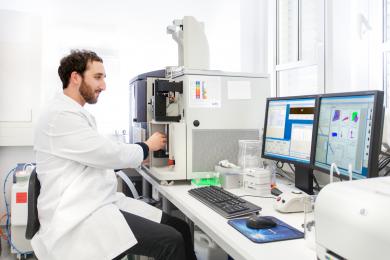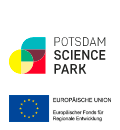- en
- de
Diabetes Drug May Improve Bone Fat-induced Defects of Fracture Healing
► A large number of preadipocytes can be identified or analyzed by the FACS® (Fluorescence Activated Cell Sorting) analysis. (© Till Budde/DIfE)
German Institute of Human Nutrition Potsdam-Rehbruecke (DIfE)
A press release of the Leibniz Association
March 17, 2017
Diabetes Drug May Improve Bone Fat-induced Defects of Fracture Healing
Potsdam-Rehbruecke – A new study led by the German Institute of Human Nutrition (DIfE), a partner of the German Center for Diabetes Research (DZD), shows that gliptins – well known from diabetes treatment – may oppose the detrimental effects of fat cell accumulation in the bone marrow to improve bone healing in older, overweight patients. The research team led by stem cell researchers Thomas H. Ambrosi and Tim J. Schulz has now published its findings in Cell Stem Cell (Ambrosi et al. 2017).
It is well established that aging promotes the development of obesity. The aging process is not only accompanied by larger fat depots but also by excessive atypical fat cell accumulation in other tissue types, for example in bone marrow. As recent studies suggest, such changes are associated with loss of bone mass (osteoporosis), increased risk of bone fractures, and a disturbed maturation of the immune and blood cells in the bone marrow. In addition, other studies show that people with type 2 diabetes are particularly prone to bone fractures. The biological mechanisms underlying these observations have not been sufficiently investigated. In the present study the scientists investigated the cellular and molecular causes of these processes using cell culture experiments and studies on mice.
As the researchers show for the first time, a high-fat diet, especially in combination with an advanced age, leads to an increase of specialized (adipogenic) progenitor cells in the bone marrow, which ultimately contribute to adipocyte accumulation in the bone. Excessive bone fat not only impairs bone healing, but also hampers blood cell formation in the bone marrow of the long bones. In addition, the scientists observed that bone cell development is impaired in old age. “Our investigations thus confirm the observations of previous studies and may explain why bone fractures do not heal as well in old age, especially if the patients are overweight due to a high-fat diet," says first author Ambrosi. “We identified a potential molecular link that mediates the negative effect of fat cells on bone tissue regeneration, the protein-cleaving enzyme dipeptidyl peptidase 4, better known as DPP4," adds Schulz, who led the study.
This enzyme is already well known in diabetes research because it degrades hormones that regulate glucose metabolism. Its activity promotes high blood glucose levels and impairs the function of the insulin-producing cells of the pancreas. Based on these findings, pharmaceutical companies have developed various drugs, the so-called gliptins or DPP4 inhibitors, which – taken as a tablet – reduce the negative influence of DPP4 on the blood sugar level.
“Our discovery that DPP4, in addition to its influence on glucose metabolism, plays an important role in the cellular composition of bones is particularly interesting with regard to observations that people with type 2 diabetes have a tendency to sustain bone fractures," says Ambrosi. “It points to a direct relationship between metabolic disorders and fracture susceptibility,” the scientist continues. “It also provides a novel therapeutic approach to improve the regenerative capacity of the bones by means of drugs, particularly in elderly and overweight people. It is a particular advantage that DPP4 inhibitors have been used in diabetes therapies for many years,” adds Schulz, who heads the Department of Adipocyte Development and Nutrition at the DIfE. Both agree that further research will be necessary with respect to the treatment of bone fractures using gliptins.
In addition to these investigations with immediate medical relevance, the researchers show in extensive cell-biological studies that the composition of the diet directly affects the stem cells of the bone and determines whether they form bone or adipogenic progenitor cells*. In future studies, the scientists aim to investigate how specific diets and food components can be used to support bone healing. However, the results of the study already show that people can do a lot for their bone health by following a balanced diet and by maintaining a healthy body weight, according to Schulz and Ambrosi.
In addition to DIfE/DZD scientists, the study also included researchers from the Wellcome Trust Sanger Institute and the European Bioinformatics Institute in the UK, the Monell Chemical Senses Center in the USA, the Sidra Medical and Research Center in Qatar, and Charité – Universitätsmedizin Berlin.
Background Information:
* Stem cells are generally defined as body cells which can transform (differentiate) into different cell types or tissues. Depending on the type of stem cell, they have the potential to develop into any tissue of the body (embryonic stem cells) or are more limited to certain tissue types (adult stem cells). Stem cells are able to divide asymmetrically, that is, to generate two different daughter cells. One daughter cell possesses stem cell properties; this is referred to as the ability of the stem cell for self-renewal. The second daughter cell is characterized by a greater degree of differentiation and is also referred to as a progenitor cell for a particular tissue type, for example a bone or adipogenic progenitor cell. A mechanism that has not yet been elucidated in every detail enables this asymmetric division step. The respective biological micro-environment in which they reside determines the fate of the cells, which also refers to the availability of certain nutrients or hormones, among other things.
Bone marrow contains two different adult stem cells from which on the one hand precursors for bones, fat and cartilage develop. On the other hand, it also contains stem cells from which the various blood cells, i.e. the red and white blood cells, can develop.
Publication: Ambrosi, T.H.; Scialdone, A.; Graja, A.; Gohlke, S.; Jank, A.-M.; Bocian, C.; Woelk, L.; Fan, H.; Logan, W.D.; Schürmann, A.; Saraiva, L.R.; Schulz, T.J.: Adipocyte accumulation in the bone marrow during obesity and aging impairs stem cell-based hematopoietic and bone regeneration. Cell Stem Cell (2017)
The German Institute of Human Nutrition Potsdam-Rehbruecke (DIfE) is a member of the Leibniz Association. It investigates the causes of diet-related diseases in order to develop new strategies for prevention and therapy and to provide dietary recommendations. Its research focus includes the causes and consequences of the metabolic syndrome, which is a combination of obesity, high blood pressure, insulin resistance and lipid metabolism disorder, as well as the role of diet in healthy aging and the biological basis of food choices and eating habits. More information at www.dife.de. In addition, the DIfE is a partner of the German Center for Diabetes Research (DZD), which was founded in 2009 and has since been funded by the BMBF.
The Leibniz Association is the umbrella organization for 91 independent research institutions whose spectrum encompasses the natural, engineering and environmental sciences, economics, the spatial and social sciences as well as the humanities. Leibniz Institutes address issues of social, economic and ecological relevance. They conduct knowledge-driven and applied basic research, also in the overarching Leibniz research networks; they comprise and maintain scientific infrastructure and provide research-based services. The Leibniz Association sets priorities in knowledge transfer, in particular with the Leibniz research museums. It provides advice and information for policymakers, academia, business and industry, and the general public. Leibniz institutions maintain close cooperative relationships with universities – inter alia in the form of “Leibniz Science Campi”, as well as with industry and other partners in Germany and abroad. They are subject to a transparent and independent evaluation procedure. Due to the importance of the Leibniz Institutes for Germany as a whole, they are funded jointly by the federal government and state governments, employing some 18,600 individuals, including 9,500 researchers. The overall budget of the institutes amounts to more than EUR 1.7 billion.
Contact:
Prof. Dr. Tim J. Schulz
Department of Adipocyte Development and Nutrition
German Institute of Human Nutrition
Potsdam-Rehbruecke (DIfE)
Arthur-Scheunert-Allee 114-116
14558 Nuthetal/Germany
phone: +49 (0)33200 88-2114/-2110
e-mail: tim.schulz@dife.de
Thomas Ambrosi
Department of Adipocyte Development and Nutrition
German Institute of Human Nutrition
Potsdam-Rehbruecke (DIfE)
Arthur-Scheunert-Allee 114-116
14558 Nuthetal/Deutschland
phone: +49 (0)33200 88-2111
e-mail: thomas.ambrosi@dife.de
Media Contact:
Dr. Gisela Olias
Press and Public Relations Coordinator
German Institute of Human Nutrition
Potsdam-Rehbruecke (DIfE)
phone: +49 (0)33200 88-2278/-2335
e-mail: olias@dife.de
or presse@dife.de












